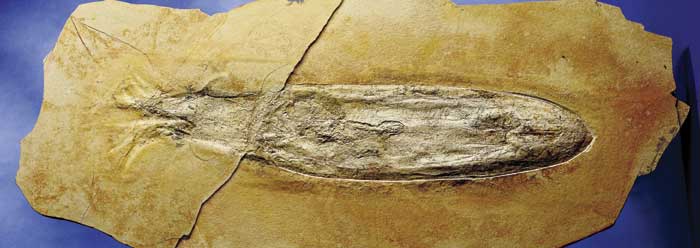During a recent tour of the fossil displays on ICR's campus, a Dutch-speaking group referred to our fossil squid as an inktvis or "ink fish." This led to the discussion of a discovery in 2009, where researchers reconstituted dried ink from a squid's fossilized ink sac.1 The paleontologists even drew a picture of what that extinct squid looked like using its very own ink!
Because the squid was found in a rock assigned an age of 150 million years, scientists were "stunned" that it "still looks as if it is modern squid ink."2 No ink should have been found.
The squid at ICR is a body-impression fossil without ink or other original tissue present. However, the fact that fossils of soft-bodied organisms--like squid, jellyfish, sponge embryos, or algae--even exist is a direct contradiction of Darwin's primary explanation for the lack of fossilized transitional forms that should be there if his life origins story is accurate. He wrote that "no organism wholly soft can be preserved."3
But many "wholly soft" organisms were preserved. A five-centimeter-long fossil of a squid-like cephalopod has been found in a "Middle Cambrian" zone in Canada's Burgess Shale, near the very bottom of earth's fossil-bearing rocks. Cambrian rocks appear to represent catastrophic marine deposits made at the beginning of the Flood year.4
Named Nectocaris pteryx, it only had two tentacles and lacked the internal shell that modern squids have. The existence of this creature in this stratum forces the re-evaluation of many longstanding evolutionary conjectures about squid origins. Martin Smith of the University of Toronto, a co-author of the Nectocaris study that appeared in Nature,5 admitted that "we know very little about the relationships between the major groups of molluscs, and the early history of the group."6 Paleontologist Donald Prothero speculated in 2004 about an evolutionary "radiation" of new cephalopod forms from a shelled ancestor:
The earliest known cephalopod, Plectronoceras, is a tiny Late Cambrian form with a simple conical shell, but it has chambers, septa, and a siphucle. From such simple origins, the straight-shelled cephalopods underwent a spectacular Ordovician radiation.7
But Nectocaris had side fins, large gills, a flexible siphon for propulsion, a streamlined body for moving quickly through water, and refracting-lens eyes--like vertebrate eyes--perched on eyestalks.8 "Early" cephalopods were anything but "simple."
Also, if the fossil record is supposed to show increasingly complicated features as one ascends the geologic column, then why does this already complicated creature appear at the bottom?
A new evolutionary story will no doubt be written. It could speculate that shell-less Nectocaris might have evolved into a shelled form, maybe with an internal shell like squids, or an external one like nautiloids. Or, it could have been a "dead end" form, irrelevant to cephalopod origins. Or, it could have come from shelled creatures that were never preserved as fossils. Perhaps it lost that shell, and some of its descendants regained it--or didn't.
Nobody will ever know, because fossils alone cannot provide as reliable a historical framework as the Bible. The best explanation for the existence of this creature remains the one presented in Genesis--each squid kind was created fully formed from the beginning.
References
- Thomas, B. Fresh Jurassic Squid Ink. ICR News. Posted on icr.org August 27, 2009.
- The 150 million-year-old squid fossil so perfectly preserved that scientists can make ink from its ink sac. Archaeology Daily News. Posted on archaeologydaily.com August 18, 2009, accessed June 7, 2010.
- Darwin, C. 1968. The Origin of Species. J. W. Burrow, ed. Middlesex, UK: Penguin Books Inc., 298.
- See Sherwin, F. and B. Thomas. 2010. Understanding Evidence for the Biblical Timescale. Acts & Facts. 39 (4): 16-17.
- Smith, M. R. and J. Caron. 2010. Primitive soft-bodied cephalopods from the Cambrian. Nature. 465 (7297): 469-472.
- Bettam, S. U of T paleontologists solve mystery of 500 million-year-old squid-like carnivore. University of Toronto press release, May 27, 2010.
- Prothero, D. 2004. Bringing Fossils to Life: An Introduction to Paleobiology, 2nd ed. Boston, MA: McGraw-Hill, 314.
- The Nature study stated that dark muscovite crystals formed inside the hollow eye-cavity and were "consistent with a camera-type construction."
* Mr. Thomas is Science Writer for the Institute for Creation Research.
Cite this article: Thomas, B. 2010. Tentacular Squid: Rewriting Squid Stories Before the Ink Dries. Acts & Facts. 39 (8): 18.













